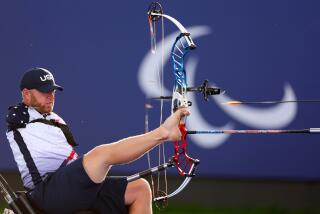Wheelchair Athletes Stress the ‘Able’ in Disabled
- Share via
The game of tennis was not designed for cripples. Neither were basketball, skiing, the 100-yard dash and mountain climbing.
But people like Dave Kiley won’t take no for an answer. Last weekend, he was scooting around in his wheelchair at the La Casa de Vida sports club in Torrance, taking on other top disabled athletes in the fourth Norris Foundation Wheelchair Tennis Classic.
Kiley, 33, of San Dimas, uses a specially built lightweight chair. The disabled athletes are allowed two bounces of the ball on a return shot but otherwise the rules are the same as in any game played by the able-bodied champs.
“It’s incredible how fast they can move around,’ said Linda Stoddart, one of 35 volunteers who organized the event to benefit programs for the disabled. “The development of their upper bodies is awesome.”
Kiley teamed with 27-year-old Randy Snow of Fresno to take first place in men’s doubles. They wheeled back and forth, accelerating and braking by slapping the rubber wheels on their chairs with the palms of their hands, all the while clutching their rackets.
“You can’t afford to be groping around for your racket,” said Kiley, who was paralyzed from the waist down in an accident 14 years ago. “You’ve got to keep your eye on the ball every second.”
While keeping his eye on the ball, partner Snow rammed his chair into a wall and sprawled on the pavement. But, in an instant, he had crawled back into his chair and zipped off to return the next volley.
The audience, some of the 500 who attended the three-day tourney, applauded wildly.
In a later interview, Snow, who holds top national honors in wheelchair tennis and basketball and is a certified scuba diver, seemed surprised that anyone noticed his spill.
“It’s nothing,” he said. “People fall down in able-bodied sports, too, don’t they?”
The active disabled--”Disabled Doesn’t Mean Unable,” a current motto goes-- seem to have developed a special attitude about problems and obstacles, and in the course of the tennis tourney, many in the audience seemed to pick it up. People seemed more friendly, a little more courteous. They smiled a lot, even at strangers.
“That spirit of camaraderie and pride does seem catching,” observed Anna Thames of Torrance, another of the tourney volunteers. “I get choked up myself when I see how these disabled athletes handle themselves and just don’t let anything get them down.”
Becky White, who came down from Fresno with Michelle Des Jarlais to win the women’s doubles, said attitude is a matter of choice, whether a person is disabled or able-bodied.
“I choose to look at my disability as a challenge that I can overcome,” said White, a former Torrance resident.
White, 34, was born without legs. Her husband died in 1981, leaving her with two children. Despite adversity, she has won world gold medals in such sports as shot put, discus and javelin throwing and the 100-yard dash.
Snow, the men’s doubles champ, suffered a broken back in 1975 when a bale of hay fell on him on a farm in his native Texas.
“Sure, I went through a period of anger and depression,” he said. “But eventually I realized that while I could do 10,000 things before my accident, I can still do 9,000 of them--more than enough to bring joy into every day that I live.”
Kiley, at 19, never walked again after crashing into a tree at Big Bear while sliding down a snowy slope on an inner tube.
“The opportunity is there for anyone to give up,” he said. “But I’ve always loved to compete, and being disabled is just another arena in which I can test my abilities and prove to myself that my life can be anything I want it to be.”
Kiley and the other disabled athletes said participation in competitive sports was the key factor in finding positive new directions in their lives. He heads the wheelchair sports program at the Pomona-based Casa Colina Hospital, which has rehabilitation facilities in Torrance and San Pedro.
The hospital’s Condors basketball team, coached by Kiley, has won five national championships in the last seven years.
Kiley said his greatest endurance test was climbing Mt. Guadalupe, the tallest mountain in Texas, several years ago. Four other athletes started out, but two had to turn back before reaching the 8,751-foot peak. Nobody was permitted to help the climbers, Kiley said.
“Sometimes we propelled ourselves up the slope in our wheelchairs,” he said. “Most of the time, we crawled, pulling everything behind us. It took five days and six nights to get to the top.”
What was it like at the top?
“Total jubilation,” Kiley said.
More to Read
Go beyond the scoreboard
Get the latest on L.A.'s teams in the daily Sports Report newsletter.
You may occasionally receive promotional content from the Los Angeles Times.










